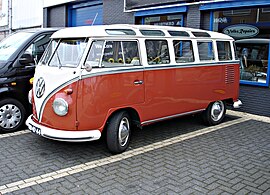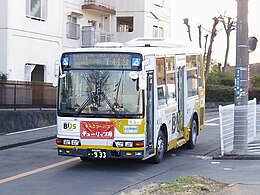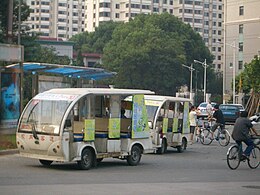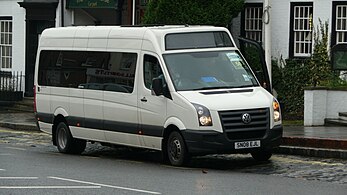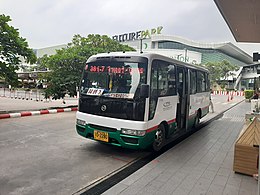
Minivan is a car classification for vehicles designed to transport passengers in the rear seating row(s), with reconfigurable seats in two or three rows. The equivalent classification in Europe is MPV or M-segment.

A van is a type of road vehicle used for transporting goods or people. Depending on the type of van, it can be bigger or smaller than a pickup truck and SUV, and bigger than a common car. There is some variation in the scope of the word across the different English-speaking countries. The smallest vans, microvans, are used for transporting either goods or people in tiny quantities. Mini MPVs, compact MPVs, and MPVs are all small vans usually used for transporting people in small quantities. Larger vans with passenger seats are used for institutional purposes, such as transporting students. Larger vans with only front seats are often used for business purposes, to carry goods and equipment. Specially equipped vans are used by television stations as mobile studios. Postal services and courier companies use large step vans to deliver packages.

The Volkswagen Type 2 is a forward control light commercial vehicle introduced in 1950 by the German automaker Volkswagen as its second car model. Known officially as the Transporter, Kombi or Microbus, or, informally, as the Volkswagen Station Wagon (US), Bus, Camper (UK) or Bulli (Germany), it was given the factory designation Type 2 as it followed – and was initially derived from – Volkswagen's first model, the Type 1 (Beetle).
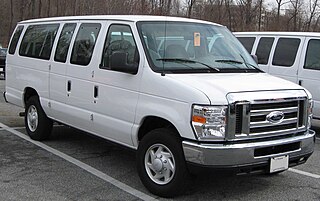
The Ford E-Series is a range of full-size vans manufactured and marketed by the Ford Motor Company. Introduced for 1961 as the replacement of the Ford F-Series panel van, four generations of the model line have been produced. Marketed for both cargo and passenger transport configurations, the E-Series has been designed with multiple design variations for both retail and commercial sale, including vans, and commercial-grade cutaway van chassis and stripped chassis.
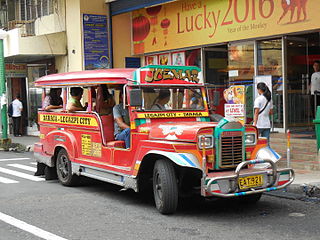
Jeepneys, sometimes called jeeps, are public utility vehicles, serving as the most popular means of public transportation in the Philippines. They are known for their crowded seating and kitsch decorations, which have become a widespread symbol of Philippine culture and art. A Sarao jeepney was exhibited at the Philippine pavilion at the 1964 New York World's Fair as a national image for the Filipinos.
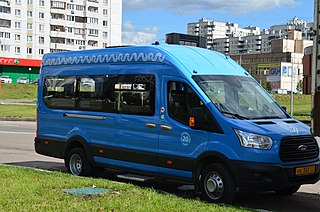
Marshrutnoye taksi, commonly known by the colloquialism Marshrutka, are share taxis found in Eastern Europe and the republics of the former Soviet Union. Usually vans, they drive along set routes, depart only when all seats are filled, and may have higher fares than buses. Passengers can board a marshrutka anywhere along its route if there are seats available.

A pesero, combi, micro or microbús is a form of public transport, most commonly seen in Mexico City. Its name derives from the fact that in the beginning of this form of transport a flat fee of one peso was charged per ride.
The Wayne Busette is a minibus that was assembled by Wayne Corporation from 1973 to 1990. During its production, many examples of the Busette were produced as school buses. One of the first examples produced with a cutaway van chassis, the Busette mated a purpose-built school bus body with a dual rear-wheel van chassis. In North America, this configuration is now preferred by manufacturers for many other types of minibuses in addition to school buses.

Cutaway van chassis are used by second stage manufacturers for a wide range of completed motor vehicles. Especially popular in the United States, they are usually based upon incomplete vans to be bigger or smaller than pickup trucks and SUVs made by manufacturers such as Chrysler, Ford, and General Motors which are generally equipped with heavier duty components than most of their complete products. To these incomplete vehicles, a second stage manufacturer adds specific equipment and completes the vehicle. Common applications of this type of vehicle design and manufacturing includes small trucks, school buses, recreational vehicles, minibuses, and ambulances. The term "cutaway" can be somewhat of a misnomer in most of the vehicle's context since it refers to truck bodies for heavy-duty commercial-grade applications sharing a common truck chassis.

The LDV Pilot was the last of a series of a panel vans that was produced by from 1974 until 2005, originally as the 1974 Leyland Sherpa developed by the Austin-Morris division of British Leyland, which was in turn derived from earlier light commercials produced by the British Motor Corporation.

The Iveco Daily is a large light commercial van produced by the Italian automaker Iveco since 1978; it was also sold as the Fiat Daily by Fiat until 1983. Unlike the more car-like unibody Fiat Ducato, the Daily uses a separate ladder frame typical of heavier commercial vehicles. The Iveco Daily is produced at the Iveco Suzzara plant, near Mantova in Italy, where Iveco has recently made substantial investments to renew the production lines.
AMZ Kutno is an automotive company based in Kutno, Poland, that has been operating since 1999. It specializes in the design and manufacture of special bodies for commercial vehicles, such as minibuses, ambulances, security vans and special vehicles for the uniformed services. The company also produces a line of city buses and various military vehicles.
The Blue Bird Micro Bird is a bus body produced in the United States and Canada by Blue Bird Corporation. First introduced in 1975, the Micro Bird body is combined with a cutaway van chassis, with passenger capacity ranging from 10 to 30 passengers. While most examples are produced as a school bus, the Micro Bird has been sold in various configurations, including commercial-use minibuses and as a MFSAB. MFSABs are alternatives to 15-passenger vans; examples have come into use by child care centers and other organizations due to updated safety regulations.

The Mercedes-Benz L 319 is a light commercial vehicle built by Mercedes-Benz between 1955 and 1967. Larger than a standard delivery van, but smaller than a conventional light truck of the period, it was the manufacturer's first model in this class. The vehicle was offered with a range of van and truck bodies. Special application and minibus variants were also available.

The public light bus (PLB) or minibus is a public transport service in Hong Kong. It uses minibuses to provide quicker transport and to serve areas that standard Hong Kong bus lines cannot reach as efficiently. The vehicles are colloquially known by the code-switch Van仔.
The Ford Carousel is a prototype vehicle that was developed by Ford in 1973. A derivative of the third-generation Ford Econoline/Club Wagon, the Carousel explored a number of the concepts that 1980s American-market minivans later put into production, serving as an alternative to both full-size station wagons and passenger vans.

The Volkswagen ID. Buzz is a battery electric minivan produced by German manufacturer Volkswagen. Based on the dedicated battery electric MEB platform, it is the first production electric minivan from Volkswagen and part of the Volkswagen ID. series. The design of the ID. Buzz is inspired by the Volkswagen Type 2 (T1) Microbus.
Mellor Coachcraft, known simply as Mellor or Mellor Bus, is a British bus manufacturer based in Rochdale, Greater Manchester. Founded in the 1960s, Mellor has primarily produced bodywork for various different minibus chassis throughout its history. Mellor is owned by parent company, Woodall Nicholson Group, alongside Treka Bus.

MOBIpeople is a bus and coach manufacturer based in Coimbra, Portugal. The company was founded in 2008 and primarily produces minibuses, midibuses and their coach equivalents. MOBIpeople is the second largest Portuguese bus manufacturer after Caetano.




